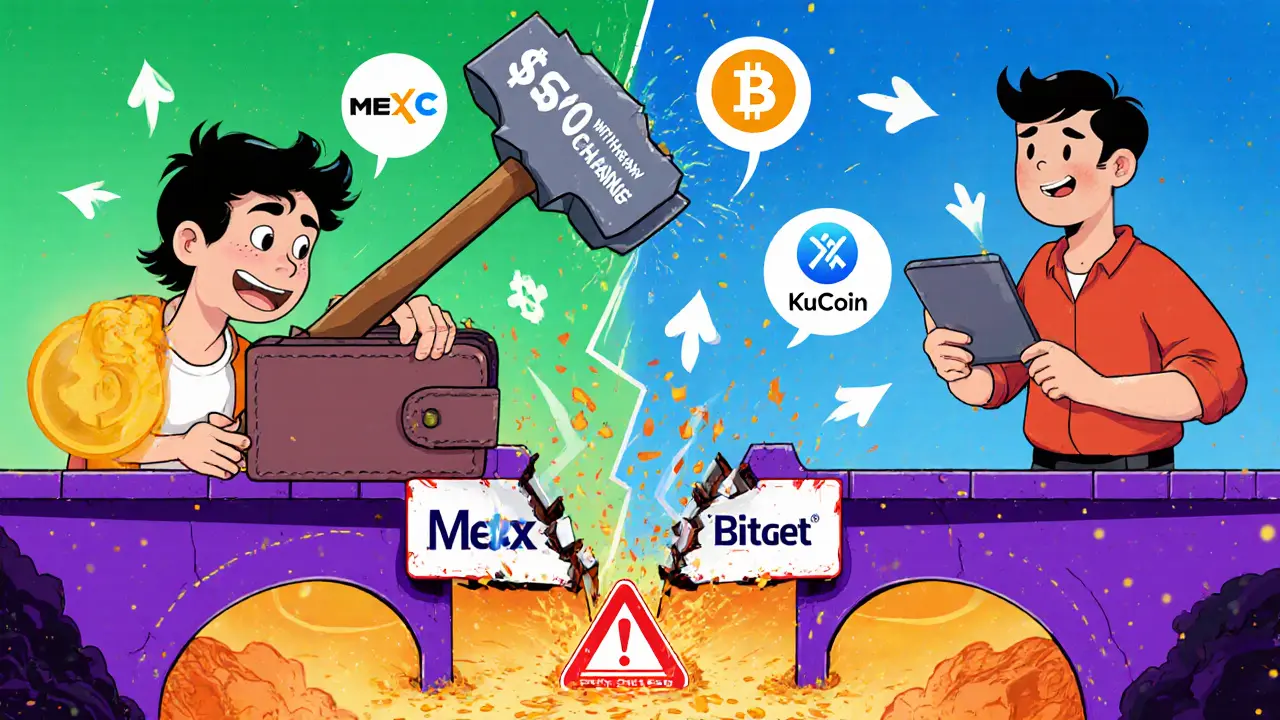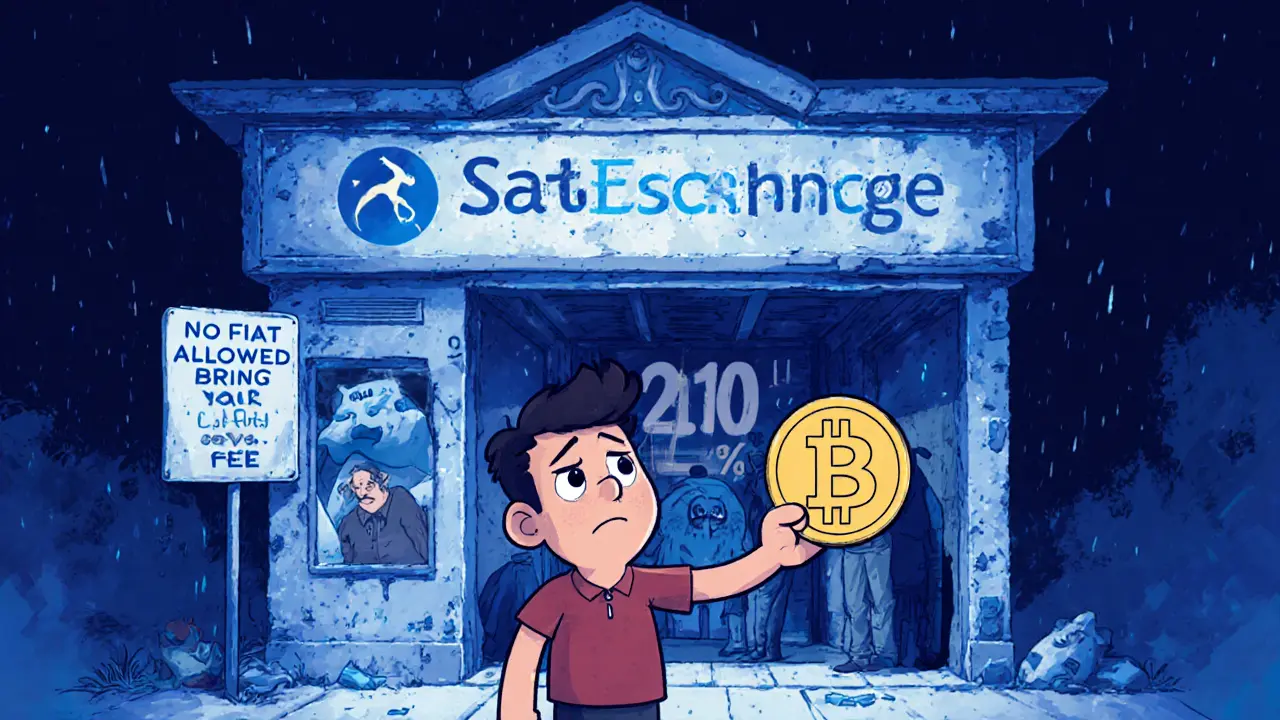SatoExchange Fee Calculator
SatoExchange charges higher fees than most exchanges. This calculator shows you exactly how much you'd pay in fees compared to industry standards.
⚠️ Important: SatoExchange charges 0.20% trading fees (higher than industry average of 0.10-0.15%), and 0.001 BTC withdrawal fees (nearly double the industry standard of 0.00053 BTC).
SatoExchange crypto exchange review: What you need to know before trading
If you're looking for a crypto exchange that lets you trade Bitcoin, Ethereum Classic, or Dogecoin without touching fiat money, SatoExchange might catch your eye. But here's the catch: it’s not for most people. Not if you're new to crypto. Not if you care about fees. And definitely not if you want to trust your funds with a platform that users are actively warning others to avoid.
SatoExchange is a decentralized exchange that only accepts crypto deposits. No USD. No EUR. No bank transfers. You need to already own cryptocurrency to even get started. That means if you just bought your first Bitcoin on Coinbase or Binance, you can’t deposit it directly into SatoExchange. You have to move it from another wallet first. That’s not a feature-it’s a barrier.
Trading fees: Flat, but not cheap
SatoExchange charges a flat 0.20% fee for both makers and takers. On paper, that sounds simple. No tiered pricing. No volume discounts. Just one number. But simplicity doesn’t mean value.
Most major exchanges today charge between 0.10% and 0.15% for spot trading. Even some smaller platforms have dropped below 0.18%. SatoExchange sits at 0.20%-higher than the current industry standard. If you trade $10,000 worth of crypto each month, that’s $20 in fees. On a competitor, it could be $15 or less. That’s $60 extra per quarter. Over a year? $240. That’s not pocket change.
And here’s where it gets worse: withdrawal fees. To pull out Bitcoin, you pay 0.001 BTC. As of late 2025, that’s roughly $60-$70 depending on price. The industry average? Around 0.00053 BTC-about $30-$40. You’re paying nearly double just to move your own coins out. Why? There’s no explanation. No justification. Just a fee that’s out of sync with the market.
The SATX token: A mystery with zero circulation
SatoExchange has its own token: SATX. It’s supposed to be a utility token-maybe for fee discounts, voting rights, or staking rewards. But here’s the problem: according to CoinMarketCap, the circulating supply of SATX is 0.
That’s not a typo. The total supply is listed as 238 million tokens. The max cap is 300 million. But not a single SATX is in circulation. That means no one can trade it. No one can use it. No one can benefit from it. Either the token was never launched, or the data is broken. Either way, it’s a red flag.
Some exchanges issue tokens as a marketing gimmick. But when the token has no actual users or trading volume, it’s not a feature-it’s a warning sign. If the team can’t even get their own token distributed, what else are they hiding?

User reviews: A platform with serious trust problems
One review site, Fxmerge, called SatoExchange “reliable and efficient.” Sounds great, right? But that review is from 2023-and it’s the only glowing one in a sea of complaints.
On Trustpilot, SatoExchange has a 1.7 out of 5 rating based on 22 reviews. That’s not just bad. That’s dangerously low. For comparison, Binance has a 4.2 rating with over 12,000 reviews. Even lesser-known exchanges like Bitrue sit at 3.8 with thousands of ratings. SatoExchange has 22. And nearly all of them are negative.
What are people saying? We don’t have exact quotes, but low ratings like this almost always point to one or more of these issues: withdrawals getting stuck, customer support ignoring tickets, or accounts being frozen without warning. When users can’t get their money out, they leave reviews like this. And they don’t come back.
Other review platforms show even less data. Cryptogeek lists a 3.0/5 rating-but it’s based on just one review. That’s not a trend. That’s noise.
No fiat? That’s not a niche-it’s a dead end
SatoExchange doesn’t support fiat deposits. That’s not a unique selling point. It’s a dealbreaker for 95% of new crypto users.
Most people don’t start with Bitcoin in their wallet. They start with $50 in their bank account. They go to Coinbase, Kraken, or Binance. They buy BTC. Then they move it to a DeFi wallet or a smaller exchange. SatoExchange wants you to be at step three-without letting you get there from step one.
It’s like opening a grocery store that only sells milk-but you have to bring your own cow first.
There’s a small group of experienced traders who hop between exchanges to avoid KYC or to trade obscure altcoins. For them, SatoExchange might seem useful. But even then, the high fees and poor reputation make it a risky choice. Why risk your funds on a platform with no regulatory disclosures, no transparent team, and a Trustpilot rating lower than a local pizza delivery service?
Regulation? No info. No transparency.
There’s zero public information about whether SatoExchange is registered anywhere. No mention of MiCA compliance in the EU. No SEC filings. No license in Singapore, Japan, or Australia. That’s not normal. It’s not niche. It’s irresponsible.
In 2025, regulation isn’t optional. It’s the baseline. Exchanges that ignore it don’t survive long-term. The ones that do-like Kraken and Bitstamp-have clear compliance pages. SatoExchange has nothing. Not even a “About Us” page that names a founder or legal entity.
If you’re holding crypto on a platform that doesn’t disclose its legal status, you’re not trading. You’re gambling.

Who is SatoExchange actually for?
Let’s be honest: almost no one.
It’s too expensive for frequent traders. It’s too risky for anyone with more than a few hundred dollars. It’s useless for beginners. And it’s not trusted by the community.
The only people who might use it are those who already have crypto, hate KYC, and don’t mind paying double the withdrawal fee for the privilege. Even then, there are better options-like MEXC or KuCoin, which offer lower fees, fiat options, and real user support.
SatoExchange feels like a project that started with good intentions but never got past the prototype stage. No updates. No roadmap. No team transparency. Just a website, a token with zero circulation, and a trail of angry reviews.
Final verdict: Avoid unless you’re testing a theory
There’s no reason to trust SatoExchange with your crypto in 2025. The fees are high. The withdrawal costs are inflated. The token is worthless. The reviews are terrible. And there’s no sign of regulatory oversight.
If you’re an advanced trader experimenting with obscure altcoins and you’ve already moved your funds from a trusted exchange? Fine. Maybe you want to test the waters. But don’t deposit more than you’re willing to lose.
For everyone else-new users, casual traders, long-term holders-there are dozens of better alternatives. Pick one that has real user feedback, competitive fees, and a clear legal standing. Your crypto deserves better than a platform with a 1.7-star rating and a token that doesn’t exist.
Does SatoExchange accept USD or other fiat currencies?
No, SatoExchange does not accept any fiat deposits like USD, EUR, or AUD. You can only deposit and trade cryptocurrencies. This makes it inaccessible for new users who need to buy crypto with bank transfers or credit cards.
What is the trading fee on SatoExchange?
SatoExchange charges a flat 0.20% fee for both makers and takers. This is higher than the industry average of 0.10%-0.15% on most major and mid-tier exchanges today.
Is the SATX token usable on SatoExchange?
No, the SATX token has a circulating supply of 0 according to CoinMarketCap. That means no one can trade it, stake it, or use it for discounts. It’s effectively non-functional and appears to be a failed or abandoned project.
Why is the Trustpilot rating so low?
SatoExchange has a 1.7/5 rating on Trustpilot based on 22 reviews as of late 2023. While specific complaints aren’t listed in public sources, low ratings like this typically indicate issues with withdrawals, customer support, or account freezes-common problems on unregulated exchanges.
Is SatoExchange regulated?
There is no public information indicating that SatoExchange holds any regulatory license in the U.S., EU, UK, Singapore, or any other major jurisdiction. This lack of transparency raises serious concerns about user fund safety and legal compliance.
Should I use SatoExchange instead of Binance or Coinbase?
No. Binance, Coinbase, Kraken, and even smaller regulated platforms like MEXC offer lower fees, fiat on-ramps, better customer support, and verified regulatory status. SatoExchange offers none of these advantages and carries significantly higher risk.
What to do instead
If you want to trade altcoins without paying high fees or risking your funds on a sketchy platform, here are three better options:
- MEXC - Low fees (0.10%-0.20%), supports 1,500+ coins, fiat on-ramp, and a 4.2/5 Trustpilot rating.
- KuCoin - No KYC for small trades, 700+ trading pairs, and a 4.0/5 Trustpilot score with over 10,000 reviews.
- Bitget - Competitive maker-taker fees, strong security, and a clear regulatory presence in multiple regions.
All of these platforms let you deposit fiat, move your crypto quickly, and get help if something goes wrong. SatoExchange doesn’t offer any of that.
Stick with exchanges that have real users, real support, and real transparency. Your crypto portfolio isn’t a gamble. Don’t treat it like one.
